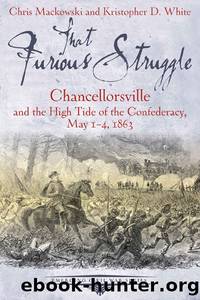That Furious Struggle: Chancellorsville and the High Tide of the Confederacy, May 1-4, 1863 by Christopher Mackowski Kristopher White

Author:Christopher Mackowski, Kristopher White
Language: eng
Format: epub
Tags: HISTORY / United States / Civil War Period (1850-1877)
ISBN: 9781611212204
Publisher: Savas Beatie
Published: 2014-07-30T00:00:00+00:00
Because of their inglorious flight, the German immigrants of the XI Corps earned the ignoble nickname âThe Flying Dutchmen.â (FSNMP)
As you head back east on Route 3, youâll follow the same route the Confederates followed as they drove the Federal army back on its heels. One of the myths of Chancellorsville is that the XI Corps completely broke and ran, but thatâs not entirely true. That perception came about because, as one historian noted, for each story of resistance and controlled withdrawal, âthere was another storyâor two or three storiesâof utter demoralization and uncontrollable panic.â
Another reason the XI Corps was so maligned had much to do with xenophobia within the Union army itself. Many of the units in the XI Corps were composed of recently emigrated Germansâmany so new to America that they spoke only a smattering of English. Even on their best days, the Germans of the XI Corps faced discrimination and derision from soldiers in other parts of the army. On May 2, when the corps collapsed under the pressure of Jacksonâs onslaught, many non-German soldiers assumed the âflying Dutchmenâ had turned tail and run simply because they were German.
Howard, for his part, later admitted, âI wanted to die,â because of the disaster that had befallen his corps. He lost some 2,400 men out of his total force of about 11,000âjust under a quarter of his forces. One thousand of them, caught off-guard by the suddenness of the attack, had been taken prisoner. In comparison, Jackson lost about 800 men.
As you travel to the next stop, 0.9 miles on the left, youâll pass the Wilderness Church. Originally built circa 1853 under the supervision of the Reverend Melzi S. Chancellor for his Baptist congregation, the wooden church stood two-and-a-half stories tall. âLittle Wilderness Church⦠looks deserted and out of place,â said a Union soldier who camped nearby on May 2. âLittle did its worshippers on last sabbath day imagine what a conflict would rage about its walls before they again could meet within its peaceful precincts.â The current church dates from 1899.
Download
This site does not store any files on its server. We only index and link to content provided by other sites. Please contact the content providers to delete copyright contents if any and email us, we'll remove relevant links or contents immediately.
| United States | Abolition |
| Campaigns & Battlefields | Confederacy |
| Naval Operations | Regimental Histories |
| Women |
In Cold Blood by Truman Capote(3306)
The Innovators: How a Group of Hackers, Geniuses, and Geeks Created the Digital Revolution by Walter Isaacson(2832)
Steve Jobs by Walter Isaacson(2831)
All the President's Men by Carl Bernstein & Bob Woodward(2326)
Lonely Planet New York City by Lonely Planet(2170)
And the Band Played On by Randy Shilts(2127)
The Room Where It Happened by John Bolton;(2102)
The Poisoner's Handbook by Deborah Blum(2089)
The Murder of Marilyn Monroe by Jay Margolis(2057)
The Innovators by Walter Isaacson(2055)
Lincoln by David Herbert Donald(1943)
A Colony in a Nation by Chris Hayes(1880)
Under the Banner of Heaven: A Story of Violent Faith by Jon Krakauer(1746)
Amelia Earhart by Doris L. Rich(1647)
The Unsettlers by Mark Sundeen(1642)
Birdmen by Lawrence Goldstone(1618)
Being George Washington by Beck Glenn(1611)
Dirt by Bill Buford(1610)
Zeitoun by Dave Eggers(1589)
